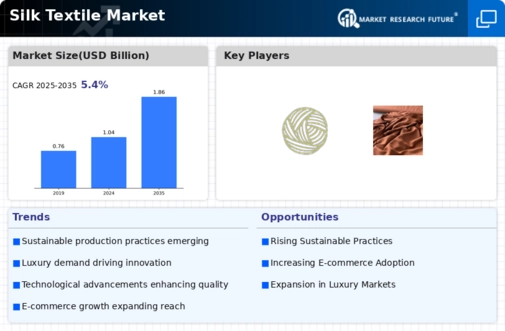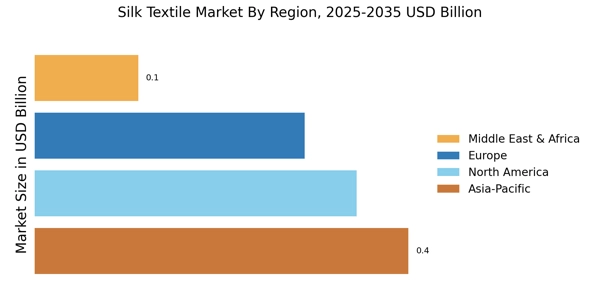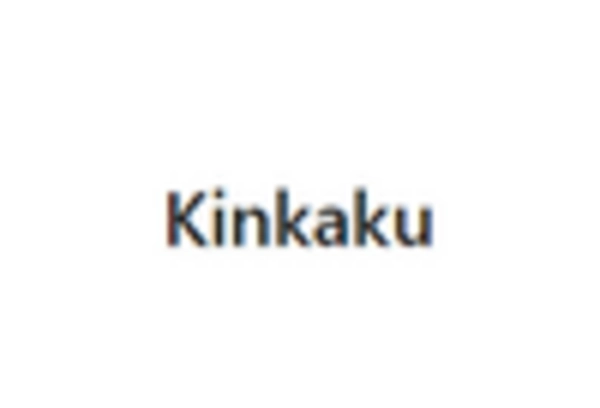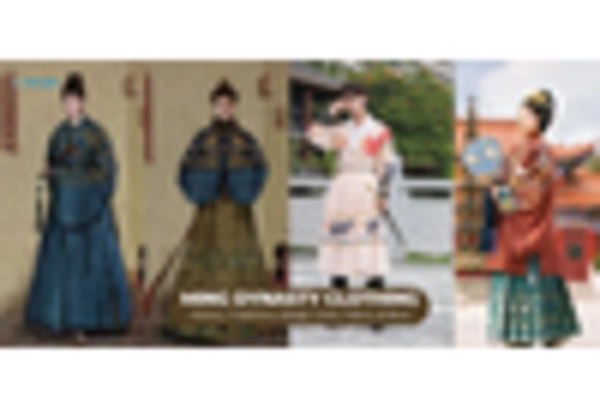Expansion of E-commerce Platforms
The Silk Textile Market is witnessing a significant expansion of e-commerce platforms, which is transforming the way consumers purchase silk products. Online shopping offers convenience and access to a wider range of silk textiles, allowing consumers to explore various styles and prices from the comfort of their homes. Recent reports indicate that e-commerce sales in the textile sector are projected to grow by 15% annually, with silk textiles being a prominent category. This trend is particularly beneficial for small and medium-sized enterprises that can reach a global audience without the need for extensive physical retail presence. Consequently, the growth of e-commerce is likely to enhance market visibility and sales opportunities for silk textile manufacturers.
Rising Demand for Luxury Textiles
The Silk Textile Market experiences a notable increase in demand for luxury textiles, driven by consumers' growing preference for high-quality, premium fabrics. This trend is particularly evident in the fashion and home decor sectors, where silk is often associated with elegance and sophistication. According to recent data, the luxury textile segment is projected to grow at a compound annual growth rate of approximately 5.5% over the next five years. This growth is fueled by affluent consumers seeking unique and exclusive products, thereby enhancing the overall market for silk textiles. As a result, manufacturers are increasingly focusing on innovative designs and sustainable practices to cater to this discerning clientele, further solidifying silk's position in the luxury textile market.
Cultural Significance and Heritage
The Silk Textile Market is deeply intertwined with cultural significance and heritage, particularly in regions where silk production has historical roots. Countries such as China and India have long-standing traditions of silk weaving, which not only contribute to the local economy but also preserve cultural identities. This cultural aspect drives demand for traditional silk textiles, as consumers seek authentic products that reflect craftsmanship and heritage. Market analysis indicates that the appreciation for artisanal and handcrafted silk items is on the rise, with a potential growth rate of 7% in this niche segment. As a result, the silk textile market is likely to benefit from the increasing consumer interest in products that embody cultural narratives and artisanal skills.
Growing Interest in Sustainable Fashion
The Silk Textile Market is increasingly influenced by the growing interest in sustainable fashion. Consumers are becoming more aware of the environmental impact of textile production and are actively seeking eco-friendly alternatives. Silk, being a natural fiber, is often perceived as a more sustainable option compared to synthetic textiles. This shift in consumer behavior is prompting brands to adopt sustainable practices, such as sourcing silk from responsible producers and implementing eco-friendly dyeing processes. Market data suggests that the sustainable fashion segment is expected to grow at a rate of 9% annually, indicating a strong potential for silk textiles that align with these values. As a result, the silk textile market is likely to benefit from this trend, attracting environmentally conscious consumers.
Technological Advancements in Production
Technological advancements play a crucial role in the Silk Textile Market, enhancing production efficiency and quality. Innovations such as automated weaving and dyeing processes have significantly reduced production costs while improving the consistency and durability of silk fabrics. Furthermore, the integration of digital technologies allows for more intricate designs and customization options, appealing to a broader range of consumers. Recent statistics indicate that the adoption of advanced manufacturing techniques could potentially increase production capacity by up to 30% in the coming years. This shift not only meets the rising demand for silk textiles but also positions manufacturers to compete more effectively in the global market, thereby driving growth in the silk textile sector.


















Leave a Comment